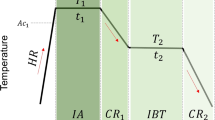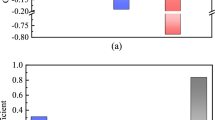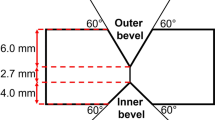Abstract
The thermal cycles necessary to produce galvanized transformation-induced plasticity (TRIP) steels on a continuous hot-dip galvanizing line involve several processing parameters that must be chosen and strictly controlled to achieve the required mechanical properties. The resulting mechanical properties strongly depend on the optimal determination of each heat treatment variable. In this paper, a novel memetic algorithm named kernel-based gradient evolution (KGE) is implemented and coupled with a support vector regression (SVR) model to efficiently optimize the production of a cold rolled hot-dip galvanized TRIP steel. For this purpose, the most significant processing parameters (cooling rate after intercritical austenitizing, isothermal holding time at the galvanizing temperature in the bainitic region, and last cooling rate to room temperature) were thus optimized to achieve the required hardness values. In general, SVR fits in a satisfactory manner the relation between experimental parameters and resulting hardness which is highly non-linear in nature, and hence, it is used as objective function. Besides, KGE algorithm reveals an impressive performance since it solved the problem in less than 10 iterations. As a result, optimal solution is successfully achieved by the proposed SVR-KGE model.







Similar content being viewed by others
References
Soleimani M, Kalhor A, Mirzadeh H (2020) Transformation-induced plasticity (TRIP) in advanced steels: a review. Materials Science and Engineering A 795. https://doi.org/10.1016/j.msea.2020.140023
Matlock D, Speer J (2010) Processing opportunities for new advanced high-strength sheet steels. Materials and Manufacturing Processes 25:7–13. https://doi.org/10.1080/10426910903158272
Guzman-Aguilera JJ, Gonzalez CM, Baltazar-Hernandez V, Basak S, Panda S, Razmpoosh MH, Gerlich A, Zhou Y (2018) Influence of SC-HAZ microstructure on the mechanical behavior of Si-TRIP steel welds. Materials Science and Engineering A 718:216–227. https://doi.org/10.1016/j.msea.2018.01.108
Ou H, Tang X, Xiao J, Wang Y, Ma Z (2018) Lightweight body-in-white design driven by optimization technology. Automotive Innovation 1:255–262. https://doi.org/10.1007/s42154-018-0032-x
Park G, Zargaran A, Oh J, Trang TTT, Kim N (2022) Overcoming the strength-formability trade-off in high strength steels via cryogenic treatment. Scientific Reports 12:15411. https://doi.org/10.1038/s41598-022-19521-w
Rudnytskyj A, Varga M, Krenn S, Vorlaufer G, Leimhofer J, Jec M, Gachot C (2022) Investigating the relationship of hardness and flow stress in metal forming. International Journal of Mechanical Sciences 232:107571. https://doi.org/10.1016/j.ijmecsci.2022.107571
Mehdi Y, Tisza M (2018) Formability investigations of advanced high strength steels. IOP Conference Series: Materials Science and Engineering 448:012022. https://doi.org/10.1088/1757-899X/448/1/012022
Yi H, Sun L, Xiong X (2018) Challenges in the formability of the next generation of automotive steel sheets. Materials Science and Technology 34:1–6. https://doi.org/10.1080/02670836.2018.1424383
Ramazani, A., Quade, H., Abbasi, M., Prahl, U.: The effect of martensite banding on the mechanical properties and formability of TRIP steels. Materials Science and Engineering: A, 160–164 (2015). https://doi.org/10.1016/j.msea.2015.10.111
Chang Y, Wang M, Wang N, Li X, Wang C, Zheng G, Ren D, Dong H (2018) Investigation of forming process of the third-generation automotive medium-Mn steel part with large-fractioned metastable austenite for high formability. Materials Science and Engineering: A 721:179–188. https://doi.org/10.1016/j.msea.2018.02.084
Pavlina EJ, Vantyne C (2008) Correlation of yield strength and tensile strength with hardness for steels. Journal of Materials Engineering and Performance 17:888–893. https://doi.org/10.1007/s11665-008-9225-5
Song, M., Sun, C., youxing Chen, Shang, Z., Li, J., Fan, Z., Hartwig, K., Zhang, X.: Grain refinement mechanisms and strength-hardness correlation of ultra-fine grained grade 91 steel processed by equal channel angular extrusion. International Journal of Pressure Vessels and Piping, 212–219 (2019). https://doi.org/10.1016/j.ijpvp.2019.03.025
Busby J, Hash M, Was G (2005) The relationship between hardness and yield stress in irradiated austenitic and ferritic steels. Journal of Nuclear Materials 336:267–278. https://doi.org/10.1016/j.jnucmat.2004.09.024
Rosenberg, G., Gašiko, M.: Correlation between hardness and tensile properties in ultra-high strength dual phase steels - short communication. Materials Engineering 18, 155–159 (2011)
Pavlina E, Vantyne C (2014) Uniform elongation and the stress-strain flow curve of steels calculated from hardness using empirical correlations. Journal of Materials Engineering and Performance 23:2247–2254. https://doi.org/10.1007/s11665-014-1037-1
Li Y, Ding W, Wang B (2019) Intercritical annealing pre-treatment used in a hot-dip galvanised trip steel. Materials Science and Technology 35:1–9. https://doi.org/10.1080/02670836.2019.1625171
Wiewiorowska, S., Muskalski, Z., Michalczyk, J.: The influence of hot dip galvanizing process on trip steel wire structure and properties. Archives of Metallurgy and Materials 64, 129–132 (2019). https://doi.org/10.24425/amm.2019.126228
Li, Z.C., Zhang, X.T., Mou, Y.J., Misra, R.D.K., He, L.F., Li, H.P.: The impact of intercritical annealing in conjunction with warm deformation process on microstructure, mechanical properties and TRIP effect in medium-Mn TRIP steels. Materials Science and Engineering: A 746 (2019). https://doi.org/10.1016/j.msea.2019.01.035
Xiong J, Shi S-Q, Zhang T-Y (2020) Machine learning of mechanical properties of steels. Science China Technological Sciences 63:363–371. https://doi.org/10.1007/s11431-020-1599-5
Mia M, Dhar N (2019) Prediction and optimization by using SVR, RSM and GA in hard turning of tempered AISI 1060 steel under effective cooling condition. Neural Computing and Applications 31:2349–2370. https://doi.org/10.1007/s00521-017-3192-4
Xie Q, Suvarna M, Li J, Zhu X, Cai J, Wang X (2021) Online prediction of mechanical properties of hot rolled steel plate using machine learning. Materials & Design 197:109201. https://doi.org/10.1016/j.matdes.2020.109201
Carneiro M, Salis T, Almeida GD, Braga A (2021) Prediction of mechanical properties of steel tubes using a machine learning approach. Journal of Materials Engineering and Performance 30:434–443. https://doi.org/10.1007/s11665-020-05345-0
Flor-Sánchez C, Reséndiz-Flores E, Altamirano G (2022) Kernel-based gradient evolution optimization method. Information Sciences 602:313–327. https://doi.org/10.1016/j.ins.2022.04.057
Tanabe, R., Fukunaga, A.: Improving the search performance of shade using linear population size reduction. In: 2014 IEEE Congress on Evolutionary Computation (CEC), pp. 1658–1665 (2014). https://doi.org/10.1109/CEC.2014.6900380
Wagdy A, Hadi A, Jambi K (2018) Novel mutation strategy for enhancing SHADE and LSHADE algorithms for global numerical optimization. Swarm and Evolutionary Computation 50. https://doi.org/10.1016/j.swevo.2018.10.006
Neri, F.: Adaptive covariance pattern search. In: Applications of evolutionary computation, pp. 178–193 (2021). https://doi.org/10.1007/978-3-030-72699-7_12
Petrov, R.H., Sidor, J., Kestens, L.A.I.: Encyclopedia of iron, steel, and their alloys (online version), (2016). Chap. Advanced high-strength steels: microstructure and texture evolution
Vapnik, V.N.: The nature of statistical learning theory, (1999). Chap. 6
Chen S, Hu J, Shan L, Wang C, Zhao X, Xu W (2020) Characteristics of bainitic transformation and its effects on the mechanical properties in quenching and partitioning steels. Materials Science and Engineering: A 803:140706. https://doi.org/10.1016/j.msea.2020.140706
Ji-yuan L, Zicheng Z, Fu-xian Z, Yan-mei L, Ken-ichi M (2012) Effect of cooling method on microstructure and mechanical properties of hot-rolled C-Si-Mn TRIP steel. Journal of Iron and Steel Research, International 19:41–46. https://doi.org/10.1016/S1006-706X(12)60045-4
Wang, X.H., Kang, J., jie Li, Y., Yuan, G., Misra, R.D.K., Wang, G.-D.: Effect of cooling rates in coiling process on microstructures and mechanical properties in Al-bearing hot-rolled TRIP steel. Acta Metallurgica Sinica (English Letters) 32, 1207–1218 (2019). https://doi.org/10.1007/s40195-018-00868-x
Van H, Van C, Ngoc T, Manh T (2018) Influence of heat treatment on microstructure and mechanical properties of a CMnSi trip steel using design of experiment. Materials Today: Proceedings 5:24664–24674. https://doi.org/10.1016/j.matpr.2018.10.264
Fonstein N (2015) Advanced high strength sheet steels: physical metallurgy. Design, Processing and Properties
Acknowledgements
The author Carlos O. Flor-Sánchez is indebted to CONACYT for the financial support in the form of a scholarship for doctorate studies.
Funding
This research has been funded by the Tecnológico Nacional de México trough the research project 13519.22-P.
Author information
Authors and Affiliations
Contributions
Flor-Sánchez, C.O.: methodology, software, validation, formal analysis, investigation, resources, writing—original draft, writing review and editing, visualization. Reséndiz-Flores, E.O.: conceptualization, methodology, software, formal analysis, investigation, resources, writing—original draft, writing review and editing, supervision, project administration. Altamirano-Guerrero, G.: experimental methodology, investigation, experimental resources, experimental results interpretation, experimental review.
Corresponding author
Ethics declarations
Ethics approval
The authors declare that this manuscript was not submitted to more than one journal for simultaneous consideration. Also, the submitted work was original and has not been published elsewhere in any form or language.
Consent to participate
It is confirmed that all the authors are aware and satisfied of the authorship order and correspondence of the paper.
Consent for publication
The publisher has the permission of the authors to publish the given article.
Competing interest
The authors declare no competing interests.
Additional information
Publisher's Note
Springer Nature remains neutral with regard to jurisdictional claims in published maps and institutional affiliations.
Rights and permissions
Springer Nature or its licensor (e.g. a society or other partner) holds exclusive rights to this article under a publishing agreement with the author(s) or other rightsholder(s); author self-archiving of the accepted manuscript version of this article is solely governed by the terms of such publishing agreement and applicable law.
About this article
Cite this article
Flor-Sánchez, C.O., Reséndiz-Flores, E.O. & Altamirano-Guerrero, G. Optimal design of thermal cycles for experimental processing of advanced TRIP-assisted galvanized steels using support vector regression and kernel-based gradient evolution method. Int J Adv Manuf Technol 128, 1379–1389 (2023). https://doi.org/10.1007/s00170-023-11926-9
Received:
Accepted:
Published:
Issue Date:
DOI: https://doi.org/10.1007/s00170-023-11926-9




